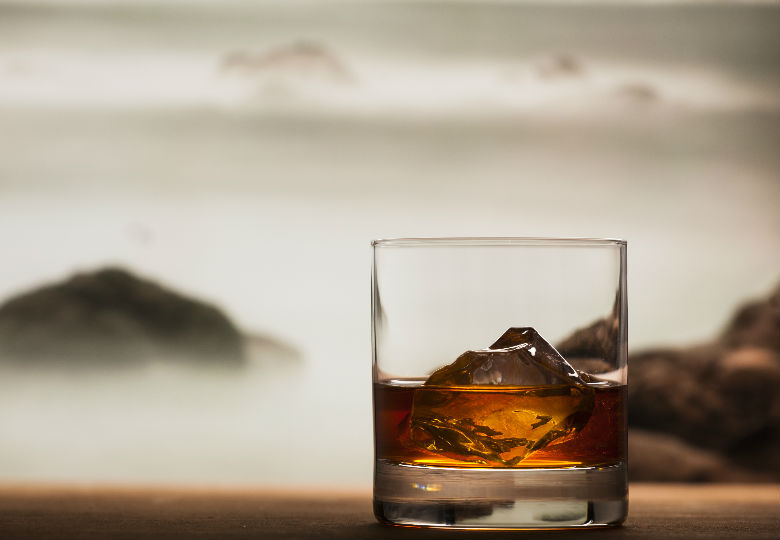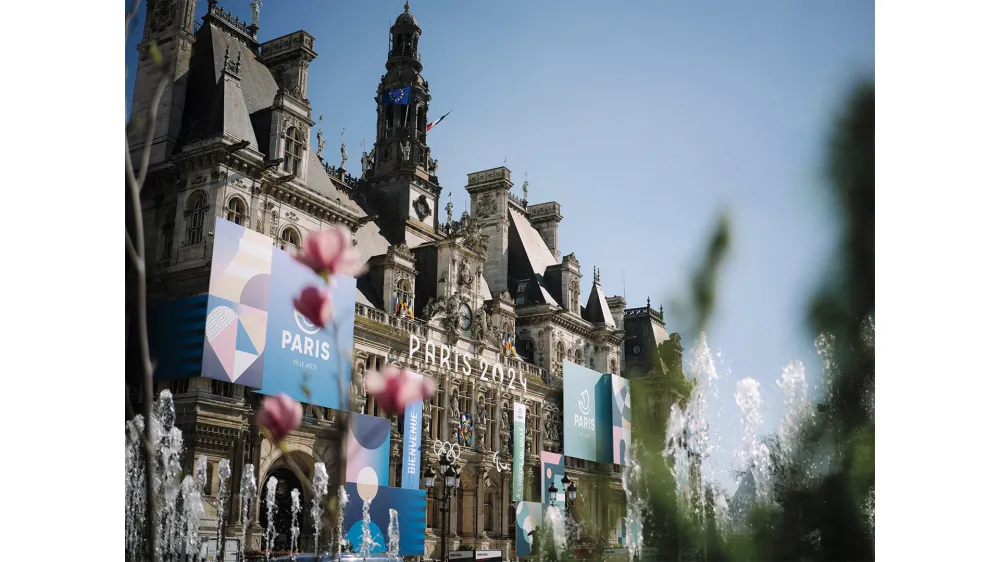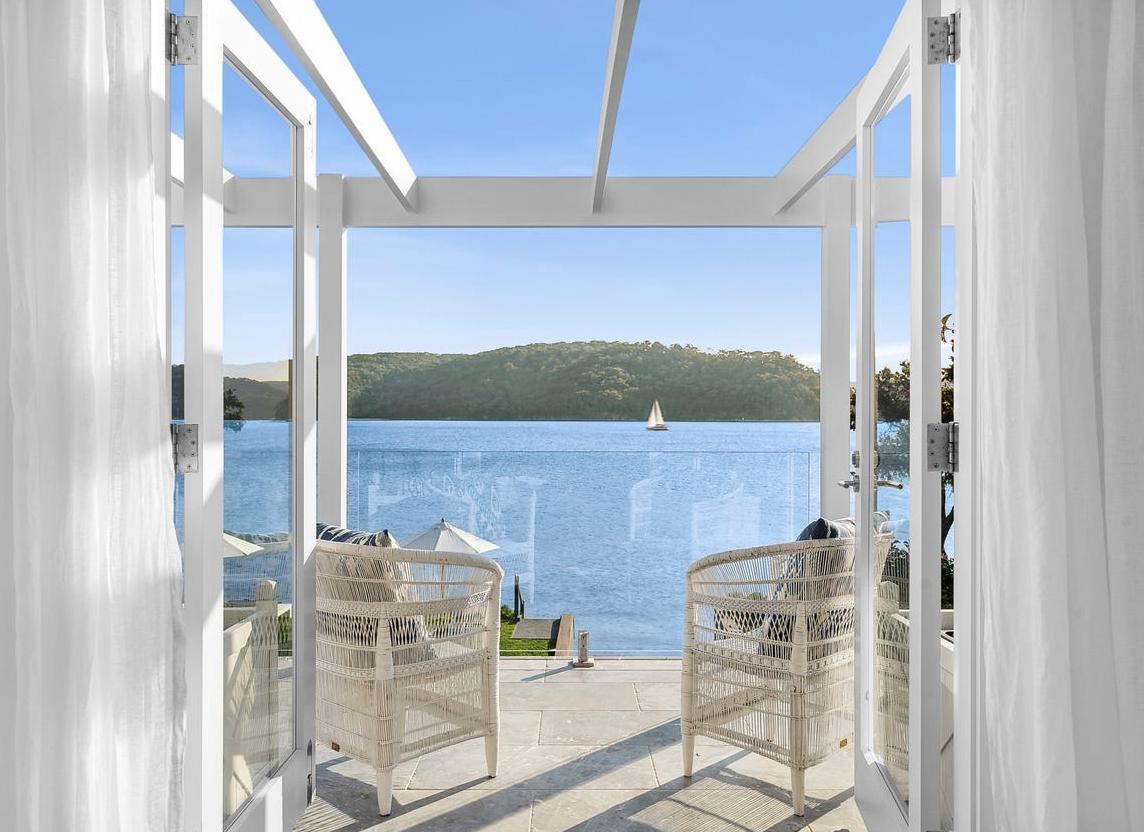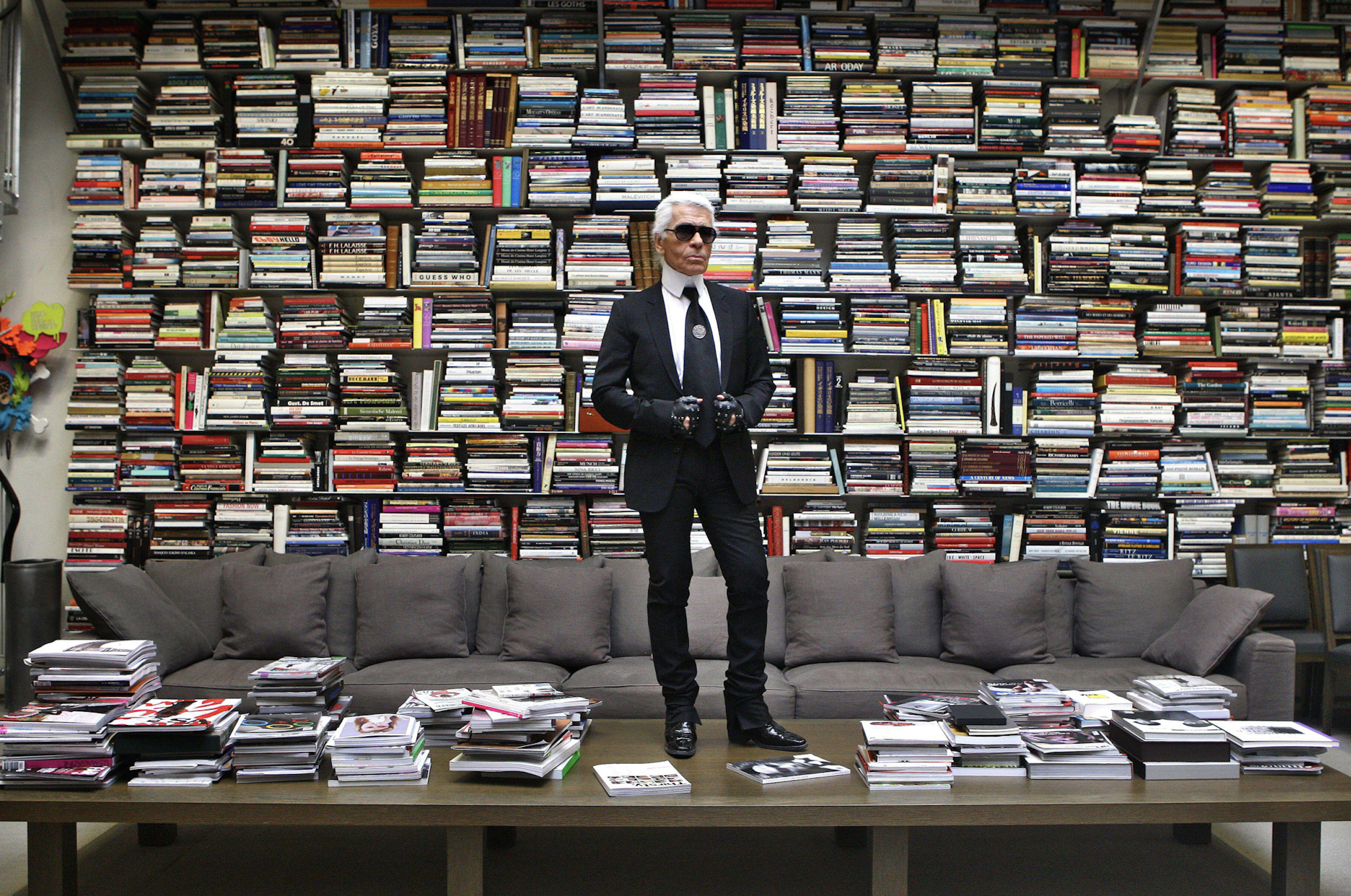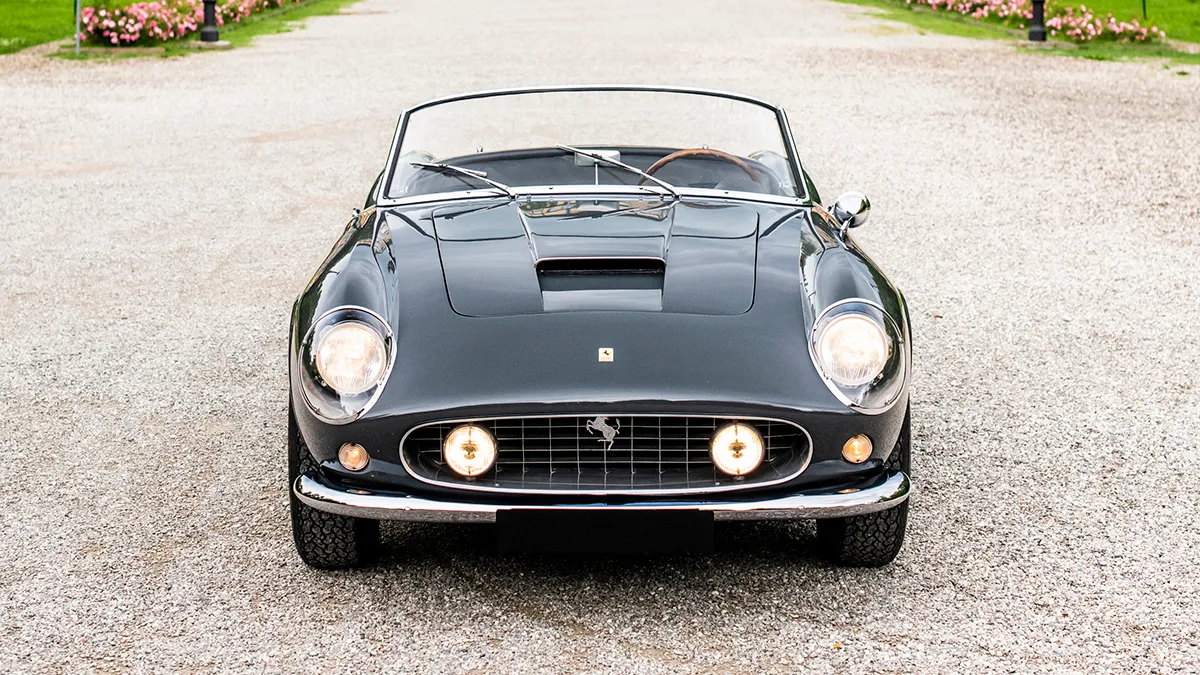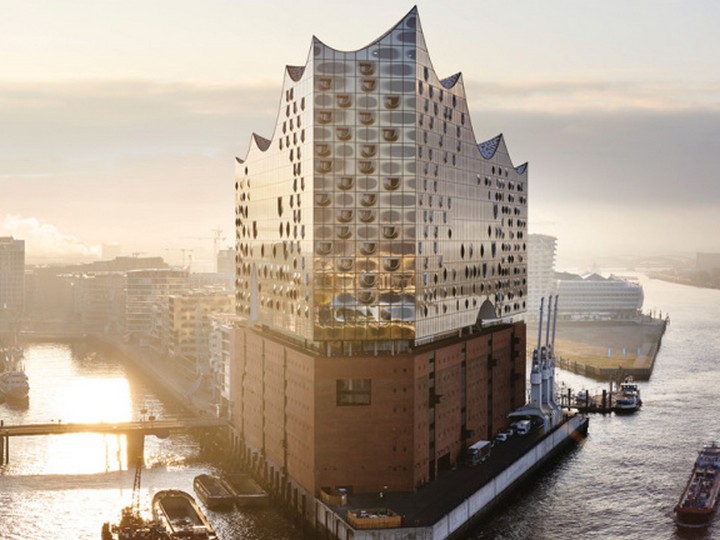
The top 21 places to travel in 2018
This year will be one for the books, with new over-the-top adventures, spectacular hotel openings, and must-see events.
Related articles
Every year, Robb Report circles the globe to uncover the up-and-coming destinations that will make for a year of amazing travel. This year will be one for the books, with new over-the-top adventures from Iceland to Antarctica, spectacular hotel openings from Cambodia to Napa Valley, and must-see events from Buenos Aires to South Korea. Whether your wanderlust has you craving a new city experience, a stunning island escape, or a safari getaway unlike any other, these 21 destinations are sure to keep you travelling in style all year long.
## Napa Valley

It may sound foolish to call Napa Valley lucky. The revered wine country seemed anything but in October, when wildfires ravaged more than 200,000 acres in Northern California, claiming thousands of homes and dozens of lives. But when the flames were finally doused and the smoke at last cleared, the valley floor, as if by some divine intervention, remained virtually untouched. Though surrounded by seared slopes and scorched trees, Napa itself — along with its scenic vineyards and glamorous resorts — appeared, however implausibly, as picturesque as ever.
Luck aside, Napa Valley has the resilience of its dedicated citizens and first responders to thank for its good fortune. A passionate committee of leaders, vintners, and luminaries, including everyone from chef Thomas Keller to designer Ken Fulk, banded together to support the people and places affected by the fires. Now the illustrious valley has but one message for the world: We’re back — and with a host of new reasons to visit.
On the culinary front, the talk of the valley is, not surprisingly, Thomas Keller, whose Michelin three-star French Laundry recently debuted a sleek revamp by the Oslo-based architecture firm Snøhetta. But there are plenty of new arrivals demanding attention too, from Christopher Kostow’s elevated-casual Charter Oak to Chris Cosentino’s refined Acacia House. Adding to the momentum is Harlan, whose elegant new Promontory is the revered wine-making family’s first endeavor to offer public tastings.
Hot hotel happenings are in abundance as well. Las Alcobas Napa Valley, a Luxury Collection Hotel, is the brightest new spot in the valley, with 68 spacious oak-filled guest rooms and suites (all with private terraces). Yountville’s Vintage House is basking in the glow of a recent renovation that brings a French-country-house vibe to its 80 bungalow-style rooms. The notable debuts will continue into this year, with Four Seasons Resort and Private Residences Napa Valley unveiling 20 homes — and eventually a neighboring hotel — among the vineyards of Calistoga’s Silverado Trail.
## Buenos Aires

Move over Miami — the Americas have a new art-world darling. This year, Buenos Aires is claiming the cultural spotlight as the first host of Art Basel Cities, a new global initiative from the giants behind the world’s biggest art fairs that will spotlight the Argentinean capital’s local arts scenes.
The multiyear partnership kicked off in November with the launch of the Art Basel Cities House, a venue set among the galleries and cafés of the chic Retiro district that will host events and workshops throughout 2018. The art cognoscenti are already marking their calendars for September, when Art Basel Cities will host a weeklong program directed by curator Cecilia Alemani of High Line Art in New York. The event will highlight more than 80 galleries across Buenos Aires, as well as emerging art and design districts like La Boca and Barracas.
Adding to the events are expansion projects throughout the city, the largest of which is a US$200 ($A251) million port improvement that aims to turn Buenos Aires into South America’s premier cruising hub. Next door, Puerto Madero is gentrifying with the Alvear Icon, a slick new hotel created by the owners of the city’s grande dame, Alvear Palace. And in Barrio Norte, the new 113-room MGallery by Sofitel is opening this summer between two 18th-century structures, embodying the city’s heady mix of old and new.
## Lake Lucerne

Something big has been brewing above Lake Lucerne. Nine years and more than US$500 ($A628) million in the making, Bürgenstock Resort — the historic Swiss hideaway that once lured the likes of Sophia Loren and Audrey Hepburn — has been reborn as a sprawling lakefront complex unlike anything Europe has ever seen. This spring, a grand event will celebrate the full-scale opening of the 148-acre project, which comprises four hotels, 12 restaurants and bars, a nine-hole golf course, private residences, and a state-of-the-art wellness center.
Among the options at Bürgenstock are the 19th-century Palace Hotel, which has been restored and renovated to its former glory; the gleaming Bürgenstock Hotel, whose 102 contemporary rooms and suites are dressed in Arana marble and American walnut; and the just-opened Waldhotel, which features one of Switzerland’s most comprehensive medical spas, with wide-ranging programs that span from preventive medicine to post-op recovery. For active types, Bürgenstock also offers championship tennis courts, a curling rink, seven helipads, a private lido, and 70 km of hiking and biking trails.
## St. Barts

St. Barts was shaping up to have a landmark 2017. New hotels were opening up left and right, giving long-established favorites like Eden Rock and Isle de France some friendly competition. The St. Barth Gourmet Festival was preparing for another impressive year, with an all-star chef lineup that would be presided over by Paris’s Eric Frechon. And next-generation restaurants like Guy Martin’s Aux Amis and Saint-Tropez offshoot Shellona were breathing new life into the island’s culinary scene. Then Irma happened. The Category 5 hurricane made landfall on the French Caribbean isle last September, wreaking havoc on its most beloved haunts and hideaways.
But St. Barts is banking on a victorious comeback in 2018. With most shops and restaurants already open for business and many of the top villa rentals currently taking reservations, the island’s glitzy nautical events — including March’s Bucket Regatta and April’s Les Voiles de Saint Barth — will go on as planned. Colombier newcomer Villa Marie Saint-Barth and Hotel Christoper St. Barth will reopen their doors in time for both events. More progress will come this summer, when Grand Cul-de-Sac’s Le Guanahani will unveil an upgraded look. The biggest openings, however, will come at the end of the year, when Hotel Le Toiny relaunches with eight new villas (each with its own private pool) and the hilltop Hôtel Barrière Le Carl Gustaf makes its highly anticipated debut with an outpost of France’s Le Fouquet’s restaurant and a Biologique Recherche spa. In true St. Barts style, every opening is sure to be a fashionable fête.
## Antarctica

Don’t fear the Drake Passage. The notorious stretch of sea that lies between the tip of South America and Antarctica is as legendary as it is mercurial — treacherous one day, smooth as glass the next — but a necessary evil for those who wish to see the Southern Continent. This year, however, new ships are taking travellers across the Drake in so much style, a little tussle with the waves might just go unnoticed.
Taking Antarctic adventures to new heights — and depths — is the 200-passenger Scenic Eclipse, which will debut in August with two helicopters, a seven-passenger submarine, and 12 custom Zodiacs for polar exploration, as well as onboard luxuries like a spa, an indoor swimming pool, and butler service. Meanwhile, Silversea’s new Silver Cloud Expedition is making waves of its own with a 1-to-1 crew-to-passenger ratio and a Relais & Châteaux restaurant. Also launching this year are French cruise line Ponant’s first two ice-class Explorers ships, Le Champlain and Le Laperouse, both of which will feature underwater lounges that immerse passengers in the views — and sounds — of the surrounding waters.
For those who wish to bypass the Drake altogether, a pair of new private-jet journeys is bringing travelers to the seventh continent by way of the sky. Naya Traveller’s high-flying adventure takes guests on an 8-day itinerary that includes stops in the South Pole and the emperor-penguin-filled Atka Bay, and overnight accommodations in luxe igloos. And for a quickie touchdown amid the White Desert, book Natural World Safaris’ One Day Antarctica Adventure charter, which jets travellers in for 8 hours of exploration among the continent’s epic landscapes.
## Cambodia

No visit to Cambodia would be complete without a trip to Angkor Wat, but this year you’ll want to venture farther into the country than ever before, from its remote rain forests to its isolated islands. The Koh Rong archipelago has earned its Cambodian Riviera nickname for its recent influx of luxury beach resorts, the newest of which are the Six Senses Krabey Island — a 40-villa retreat set to debut in August on a 30-acre private isle — and Alila Villas Koh Russey, opening later this year with 50 pavilions and 13 private residences. On the mainland, Cardamom National Park will be the rain-forest home of hospitality designer extraordinaire Bill Bensley’s Shinta Mani Wild, an ambitious and utterly over-the-top safari-style camp with 16 tents implausibly perched over a kilometre-long stretch of river and waterfalls. There’s news in the cities, too: Rosewood Phnom Penh will debut early this year in a glistening tower above the Mekong River, and for a luxurious option on your Angkor Wat stop, Bensley’s new Shinta Mani Angkor features 10 villas, each with its own private pool and garden.
## New Orleans

The Big Easy is turning 300 this year, and it’s celebrating in appropriately big style. The Southern Creole city — which was founded in 1718 by the French-Canadian explorer Jean-Baptiste Le Moyne de Bienville — will honour its Tricentennial with a year’s worth of events, openings, and citywide improvements, from a much-needed makeover of Bourbon Street and a US$100 ($A125) million riverfront revitalisation to the debut of the Sazerac House, a museum devoted entirely to the locally revered cocktail.
Celebrate by checking into the recently reopened Pontchartrain Hotel, the Garden District’s circa-1927 grande dame that has been reborn as an elegant blend of old NOLA and new luxury with restored Charles Reinike murals and antique furnishings. The local culinary scene is heating up, too, with Top Chef Nina Compton’s Caribbean-eclectic Compère Lapin and James Beard Award finalist Isaac Toups’s Cajun-fusion Toups South leading a smart revival in elevated dining. And keeping the tricentennial party going well into the future are two major developments: The Louis Armstrong International Airport’s US$917 million ($A1.15 billion) César Pelli–designed terminal and, across town, a Four Seasons hotel and residences that will revitalise the city’s former World Trade Center complex.
## Rwanda

Until recently, Rwanda wasn’t on many must-see safari lists. But this year, the beautiful country with a heartbreaking past is bursting onto the African travel scene with a trio of new luxury lodges — the first of which is Wilderness’s innovative Bisate Lodge — and a fresh approach to the safari experience.
## Mexico City

This year, Mexico City becomes the first destination in the Americas to be named the World Design Capital. The honor is not to be taken lightly: The yearlong event will not only draw world-class exhibitions and innovators, but will also cement the Mexican capital’s standing as a mecca for the arts.
The 2018 program will focus on socially responsible design, with an emphasis on creating more livable, international cities. Utterly international — if not always livable — Mexico City has given the design faithful plenty to hold dear in the last few years, with contemporary museums like the avant-garde Museo Jumex and fairs like Zona Maco adding to the long-revered local scene established by such institutions as Casa Luis Barragán and Casa Azul. Design is also part of the package at hotels like Las Alcobas Mexico City — a Yabu Pushelberg creation that will debut a host of renovations later this year — and Hotel Habita (hotelhabita.com), a sleek boutique in upscale Polanco. Even the culinary scene comes with a touch of the inventive, whether it’s “living mole” at Enrique Olvera’s recent revival of Pujol or mezcal cocktails topped with ants at Fifty Mils, the new speakeasy-style bar at the Four Seasons Hotel Mexico City.
## South Korea

South Korea may not be the Korea on your mind these days — but it should be. Next month, the country will claim the world spotlight as the host of the 23rd Olympic Winter Games. In preparation, the sleepy northern ski town of Pyeongchang has reinvented itself, spending US$10 ($A12.5) billion on futuristic new sporting venues and sleek hotels, including the 238-room InterContinental Alpensia Pyeongchang Resort and the nearby Richard Meier–designed Seamarq. A new high-speed rail line linking the mountain retreat tothe capital city of Seoul in less than an hour is also making it easy to access the games with a side of après-culture. But the reasons to visit South Korea won’t end with the last medal ceremony: This year also marks the debut of Jeju Shinhwa World, an expansive resort development on idyllic Jeju Island that will eventually be home to luxury residences, entertainment venues, and a new Four Seasons resort.
## Shanghai

Is there ever a quiet moment in Shanghai? China’s fabulously frenetic metropolis seems to be in a perpetual state of advancement, and this year it’s firing on all cylinders. From the leafy boulevards of the French Concession to the towering skyscrapers of Pudong, it seems every corner of this captivating city has something new for travellers.
## Iceland

You may know Iceland best for its volcanoes, glaciers, and geysers, but this year the country is cultivating a more cosmopolitan side. No longer a mere pit stop en route to the sky-dancing Northern Lights or brooding ice caves, Reykjavík is becoming an attraction in its own right.
Visitors to the Icelandic capital can choose from sleek new properties including the Sandhotel — a 52-room boutique with an eclectic style that fits somewhere between Scandinavian cool, Danish hygge, and Art Deco chic — and the exclusive Tower Suites, a collection of eight high-design accommodations decorated with furnishings by Tom Dixon, Fritz Hansen, and Moooi. Later this year, the Reykjavik Edition will debut, claiming a coveted location next to the sparkling glass Harpa Concert Hall.
A craft-cocktail scene has also taken hold in Reykjavík, with establishments like Apotek and Loftið leading a spirited revolution. And come spring, the forefather of New Nordic cuisine, René Redzepi, will open a pop-up of his legendary Noma in the city.
Of course, Iceland remains first and foremost the Land of Ice and Fire, and new offerings among the country’s many natural wonders are elevating the great outdoors as well. Set to open in April, the Retreat at Blue Lagoon Iceland will bring an upscale experience to the well-known geothermal hot springs of Grindavík, with 62 modern suites and a subterranean spa. Most intriguing of all is the exclusive-use Eldar Lodge, a hidden-away gem nestled among the geysers of south Iceland, featuring six suites, a private chef, a wine cellar, a helipad, and two geothermal baths.
## Toronto

Canada was the talk of the travel scene last year, when the country honored its 150th anniversary with 365 days of celebrations from coast to coast. But in Toronto, the party is just getting started. This spring, the Ontario capital’s well-established cultural scene will expand anew with the opening of the Museum of Contemporary Art Toronto Canada, a 5,100-square-metre institution set within a long-abandoned industrial building in the burgeoning Junction Triangle. Phase one of the city’s ambitious Bentway — an urban-park project combining art and exhibition space across seven neighborhoods — is also slated for completion this year. And come September, when T-Dot is flooded with celebs and cinephiles for the annual Toronto International Film Festival, three new hotels will be open for business: the 44-story Bisha Hotel, with its glamorous design and rooftop pool; the sprawling Hotel X (hotelxtoronto.com), an “urban resort” leading downtown’s lakefront expansion; and the Kimpton Hotel Toronto, set in the heart of upscale Yorkville.
## Hamburg

Forget about edgy Berlin and beer-loving Munich — Hamburg is the German city to see in 2018. For evidence that this northern port city is on the rise, look no further than the Elbphilharmonie, the striking Herzog & de Meuron–designed concert hall that opened last year on the Elbe River. After countless delays and controversial budget increases, the sail-shaped venue is finally making good on its promise to put Hamburg on Europe’s modern cultural map, presenting dozens of sold-out performances in the months since it opened.
But the Elphi, as locals refer to it, isn’t Hamburg’s only modern marvel. The late Zaha Hadid designed the city’s newly completed River Promenade, a rippling walkway that winds along the Elbe, connecting many of the city’s restaurants, shops, and cultural attractions. Just north along the sparkling Alster Lake, the Fontenay Hamburg — scheduled to open this month—is being heralded as Germany’s most anticipated hotel debut in recent memory, for both its spellbinding architecture and its top-notch amenities, including a 1,000-square-metre La Mer spa and a restaurant by the Michelin-starred chef Cornelius Speinle. Also new to the hotel scene, the Sir Nikolai opened in June, bringing a stylish vibe of its own — think bohemian chandeliers and Art Deco bar carts — to one of the city’s oldest canals.
## Valletta

Though it looks more like a Game of Thrones setting than a modern cultural hub, Valletta is Europe’s of-the-moment destination for 2018. The Maltese capital — whose winding 16th-century streets have indeed served as the backdrop for several of the HBO series’s scenes — has been named the European Capital of Culture 2018. The smallest city yet to earn the distinction, Valletta is no doubt deserving: The UNESCO World Heritage site is a seamless combination of old and new, its baroque churches and Renaissance piazzas balanced by modern masterpieces like Renzo Piano’s Valletta City Gate and the soon-to-open MUŻA museum.
The city, along with select locations throughout Malta, will host more than 140 projects and 400 events over the next 12 months, including February’s Carnival, April’s Design and Technology Expo, and June’s Valletta Film Festival and Malta International Arts Festival.
Making way for the influx of visitors this year are a number of new high-design hotels, the most impressive of which is the historic Phoenicia, which reopened last year after a renovation by hotelier Gordon Campbell Gray. Elsewhere, the city’s baroque mansions are being converted into stylish boutique properties, including the eight-suite Casa Ellul and the ornate Palazzo Consiglia. Not to be outdone, Valletta’s longstanding luxury stalwart the Corinthia Palace Hotel recently unveiled a collection of new Signature Suites with private terraces overlooking the city.
## Israel

Jerusalem and Tel Aviv have long been considered Israel’s two poles: The former is embedded in its past, while the latter is hurtling toward its future. For 2018, however, the country’s major cities are trading places.
In Jerusalem, new hotels and emerging events are encouraging a savvy breed of pilgrims to look beyond its sacred sites. Just steps from HaTachana — a former railway turned trendy shopping and dining space — the new Orient Jerusalem is offering a chic boutique alternative to the city’s staid luxury hotels. Nearby, an Ottoman-era villa has been converted into Villa Brown, another fashionable property with its finger on the city’s modern pulse. That pulse will be racing in June, when the annual Jerusalem Design Week brings some of the world’s top creatives to the City of David.
In Tel Aviv, meanwhile, the city’s contemporary streak is taking a retro turn. In the revitalised port neighborhood of Jaffa, the new W Tel Aviv – Jaffa (starwoodhotels.com) will soon open within a former 19th-century convent and hospital. Nearby, the Setai Tel Aviv has claimed its own ancient abode in a carefully restored 13th-century structure set along the rugged Jaffa coast. Farther north, Dizengoff Square is getting the throwback treatment as well, with a meticulous restoration that will bring the Bauhaus landmark back to its beginnings as the city’s social hub.
## Botswana

Botswana’s abundant wildlife, private reserves, and stable political system have helped make the southern African country an eminently popular — and excessively expensive — safari destination. Now, new lodgings are bringing the country’s level of accommodation up to that of the on-the-ground experience, leaving no doubt that Botswana is Africa’s safari spot to beat.
Leading the charge is Great Plains Conservation’s Duba Plains, where a five-suite camp and an elegant two-bedroom residence opened last spring in a 77,000-acre private reserve rich with lions, Cape buffalo, and elephants. Luxury adventure at its best, the Okavango Delta escape complements Great Plains’ Zarafa, a five-suite retreat in the Selinda Reserve whose 2008 debut helped set Botswana on its upward spiral of exclusivity.
Another standard-bearer in southern Africa, Wilderness Safaris opened the eight-suite Qorokwe camp in the southeastern Okavango Delta in December. The company is also in the process of renovating its Mombo and Little Mombo camps — once considered Botswana’s definitive safari lodges — and reopening them in March in a prime location in the Okavango’s Moremi Game Reserve. Elsewhere in the Okavango, the outfitter andBeyond reopened its Nxabega Okavango Tented Camp last June, Belmond renovated its renowned Eagle Island Lodge, and Sanctuary Retreats reopened its Sanctuary Chief’s Camp with the new 620-square-metres — and as much as US$12,000 ($A15,070)-per-night—Geoffrey Kent Luxury Suite.
## Newport

The 13th Volvo Ocean Race will crisscross four oceans, six continents, and 83,340 kilometre before it reaches its final destination in the Hague this June. But the legendary around-the-world sailing competition will make only one North American stop, and that’s in the sailing mecca of Newport, R.I. For 2 weeks in May, the tony New England town will become ground zero for the seafaring extravaganza, playing host to the end of leg eight (a 10,556-kilometre journey originating in Itajaí, Brazil) and the beginning of leg nine (a transatlantic stretch culminating in Cardiff, Wales). In between, visitors to Newport’s race village can watch in-port practice sprints between the world’s most skilled sailors. For the best port views, stay at the new Gurney’s Newport Resort & Marina on Goat Island, just opposite the race village.
## St. Kitts

The buzz around St. Kitts’s Christophe Harbour has waxed and waned for years. The 2,500-acre development has been promising since 2014 to turn its West Indies home into the Caribbean’s newest hot spot. That finally might happen this year, as the harbor at last reaches a critical mass thanks to recent debuts including a marina village and the Park Hyatt St. Kitts. The former is home to 25 berths (including a handful that can accommodate superyachts up to 76 metres), as well as new boutiques, galleries, and a beachside bar. The latter, which opened in November on a golden stretch of Banana Bay, brings to the island the Caribbean’s first Miraval Life in Balance Spa. There’s more to come this year, with a Tom Fazio–designed golf course, dozens of million-dollar villas and residences, and the 1,020-square-metres Customs House (a VIP port of entry for the yachting crowd that will include a fitness centre, lounge, and marina operations post), all ensuring that the St. Kitts buzz swells well into 2019.
## Marrakech

Marrakech doesn’t need a Bilbao effect — but it might get one anyway. The Moroccan city, which was already a hit for its enchanting medina and colorful Jardin Majorelle, welcomed in October the Musée Yves Saint Laurent Marrakech, a 3,995-square-metre museum devoted entirely to the work of the fashion icon for whom it’s named. Located just a few steps from the Majorelle — Saint Laurent’s former estate that recently renovated its Berber Museum and Villa Oasis (the residence he shared with his partner in life and business, Pierre Bergé) — the ochre-coloured institution showcases thousands of sketches and couture designs. The new museum is sure to send the fashion set flocking to Marrakech, where they will have no shortage of places to stay, including the new Oberoi, Marrakech, slated for a spring debut, and the forthcoming Grace Marrakech.
## Russia

Current events aside, Russia is rife with reasons for a visit this year. As host of both the 2018 FIFA World Cup and an annual Formula 1 Grand Prix, the nation is working hard to remind travellers of the intrigue and appeal that lie beyond the heated headlines.
“Russia has been investing heavily in tourism, infrastructure, and renovations, spending a lot of time and money to get it ready for visitors,” says Jaclyn Sienna India, founder of the luxury outfitter Sienna Charles, which offers bespoke trips to the country. For U.S. travellers attending the World Cup, India notes that Russia’s typically involved entry process will become markedly easier — the country is waiving its visa requirements for attendees of the sporting event who visit between June 14 and July 15. Beyond that, booking with an in-the-know expert who has on-the-ground connections is imperative. Sienna Charles can organise such VIP experiences as after-hours museum and gallery tours, dinners in private palaces, exclusive visits to traditional bathhouses, and, of course, tickets to this year’s sporting events.
Subscribe to the Newsletter
Recommended for you
For Peat’s Sake: Scotland’s ‘Whisky Island’
There’s a reason Islay produces some of the world’s most characterful whisky. And it’s hidden in the undergrowth.
By Nick Ryan
July 22, 2024
How Paris’s Dining, Hotel and Art Scene Got Their Groove Back — Just in Time for the Olympics
The French capital’s cultural life was already on the upswing. Mix in a major global sporting event, and it’s now ready to go toe to toe with any city in the world.
By Vivian Song
July 9, 2024
You may also like.
By Josh Bozin
24/07/2024
You may also like.
5 Lounge Chairs That Add Chic Seating to Your Space
Daybeds, the most relaxed of seating solutions, offer a surprising amount of utility.
Chaise longue, daybed, recamier, duchesse brisée—elongated furniture designed for relaxing has a roster of fancy names. While the French royal court of Louis XIV brought such pieces to prominence in fashionable European homes, the general idea has been around far longer: The Egyptian pharaohs were big fans, while daybeds from China’s Ming dynasty spurred all those Hollywood Regency fretwork pieces that still populate Palm Beach living rooms. Even Mies van der Rohe, one of design’s modernist icons, got into the lounge game with his Barcelona couch, a study of line and form that holds up today.
But don’t get caught up in who invented them, or what to call them. Instead, consider their versatility: Backless models are ideal in front of large expanses of glass (imagine lazing on one with an ocean view) or at the foot of a bed, while more structured pieces can transform any corner into a cozy reading nook. Daybeds may be inextricably linked to relaxation, but from a design perspective, they put in serious work.

Emmy, Egg Collective
In designing the Emmy chaise, the Egg Collective trio of Stephanie Beamer, Crystal Ellis and Hillary Petrie, who met as students at Washington University in St. Louis, aimed for versatility. Indeed, the tailored chaise looks equally at home in a glass skyscraper as it does in a turn-of-the-century town house. Combining the elegance of a smooth, solid oak or walnut frame with the comfort of bolsters and cushioned upholstery or leather, it works just as well against a wall or at the heart of a room. From around $7,015; Eggcollective.com
 Plum, Michael Robbins
Plum, Michael Robbins
Woodworker Michael Robbins is the quintessential artisan from New York State’s Hudson Valley in that both his materials and methods pay homage to the area. In fact, he describes his style as “honest, playful, elegant and reflective of the aesthetic of the Hudson Valley surroundings”. Robbins crafts his furniture by hand but allows the wood he uses to help guide the look of a piece. (The studio offers eight standard finishes.) The Plum daybed, brought to life at Robbins’s workshop, exhibits his signature modern rusticity injected with a hint of whimsy thanks to the simplicity of its geometric forms. Around $4,275; MichaelRobbins.com

Kimani, Reda Amalou Design
French architect and designer Reda Amalou acknowledges the challenge of creating standout seating given the number of iconic 20th-century examples already in existence. Still, he persists—and prevails. The Kimani, a bent slash of a daybed in a limited edition of eight pieces, makes a forceful statement. Its leather cushion features a rolled headrest and rhythmic channel stitching reminiscent of that found on the seats of ’70s cars; visually, these elements anchor the slender silhouette atop a patinated bronze base with a sure-handed single line. The result: a seamless contour for the body. Around $33,530; RedaAmalou
Dune, Workshop/APD
From a firm known for crafting subtle but luxurious architecture and interiors, Workshop/APD’s debut furniture collection is on point. Among its offerings is the leather-wrapped Dune daybed. With classical and Art Deco influences, its cylindrical bolsters are a tactile celebration, and the peek of the curved satin-brass base makes for a sensual surprise. Associate principal Andrew Kline notes that the daybed adeptly bridges two seating areas in a roomy living space or can sit, bench-style, at the foot of a bed. From $13,040; Workshop/ APD
Sherazade, Edra
Designed by Francesco Binfaré, this sculptural, minimalist daybed—inspired by the rugs used by Eastern civilizations—allows for complete relaxation. Strength combined with comfort is the name of the game here. The Sherazade’s structure is made from light but sturdy honeycomb wood, while next-gen Gellyfoam and synthetic wadding aid repose. True to Edra’s amorphous design codes, it can switch configurations depending on the user’s mood or needs; for example, the accompanying extra pillows—one rectangular and one cylinder shaped— interchange to become armrests or backrests. From $32,900; Edra
You may also like.
By Josh Bozin
24/07/2024
22/07/2024
Watches & Wonders 2024 Showcase: Hermès
We head to Geneva for the Watches & Wonders exhibition; a week-long horological blockbuster featuring the hottest new drops, and no shortage of hype.
With Watches & Wonders 2024 well and truly behind us, we review some of the novelties Hermès presented at this year’s event.
—
HERMÈS

Moving away from the block colours and sporty aesthetic that has defined Hermès watches in recent years, the biggest news from the French luxury goods company at Watches & Wonders came with the unveiling of its newest collection, the Hermès Cut.
It flaunts a round bezel, but the case middle is nearer to a tonneau shape—a relatively simple design that, despite attracting flak from some watch aficionados, works. While marketed as a “women’s watch”, the Cut has universal appeal thanks to its elegant package and proportions. It moves away from the Maison’s penchant for a style-first product; it’s a watch that tells the time, not a fashion accessory with the ability to tell the time.
Hermès gets the proportions just right thanks to a satin-brushed and polished 36 mm case, PVD-treated Arabic numerals, and clean-cut edges that further accentuate its character. One of the key design elements is the positioning of the crown, boldly sitting at half-past one and embellished with a lacquered or engraved “H”, clearly stamping its originality. The watch is powered by a Hermès Manufacture movement H1912, revealed through its sapphire crystal caseback. In addition to its seamlessly integrated and easy-wearing metal bracelet, the Cut also comes with the option for a range of coloured rubber straps. Together with its clever interchangeable system, it’s a cinch to swap out its look.
It will be interesting to see how the Hermès Cut fares in coming months, particularly as it tries to establish its own identity separate from the more aggressive, but widely popular, Ho8 collection. Either way, the company is now a serious part of the dialogue around the concept of time.
—
Read more about this year’s Watches & Wonders exhibition at robbreport.com.au
You may also like.
22/07/2024
Living La Vida Lagerfeld
The world remembers him for fashion. But as a new tome reveals, the iconoclastic designer is defined as much by extravagant, often fantastical, homes as he is clothes.
“Lives, like novels, are made up of chapters”, the world-renowned bibliophile, Karl Lagerfeld, once observed.
Were a psychological-style novel ever to be written about Karl Lagerfeld’s life, it would no doubt give less narrative weight to the story of his reinvigoration of staid fashion houses like Chloe, Fendi and Chanel than to the underpinning leitmotif of the designer’s constant reinvention of himself.
In a lifetime spanning two centuries, Lagerfeld made and dropped an ever-changing parade of close friends, muses, collaborators and ambiguous lovers, as easily as he changed his clothes, his furniture… even his body. Each chapter of this book would be set against the backdrop of one of his series of apartments, houses and villas, whose often wildly divergent but always ultra-luxurious décor reflected the ever-evolving personas of this compulsively public but ultimately enigmatic man.
With the publication of Karl Lagerfeld: A Life in Houses these wildly disparate but always exquisite interiors are presented for the first time together as a chronological body of work. The book indeed serves as a kind of visual novel, documenting the domestic dreamscapes in which the iconic designer played out his many lives, while also making a strong case that Lagerfeld’s impact on contemporary interior design is just as important, if not more so, than his influence on fashion.
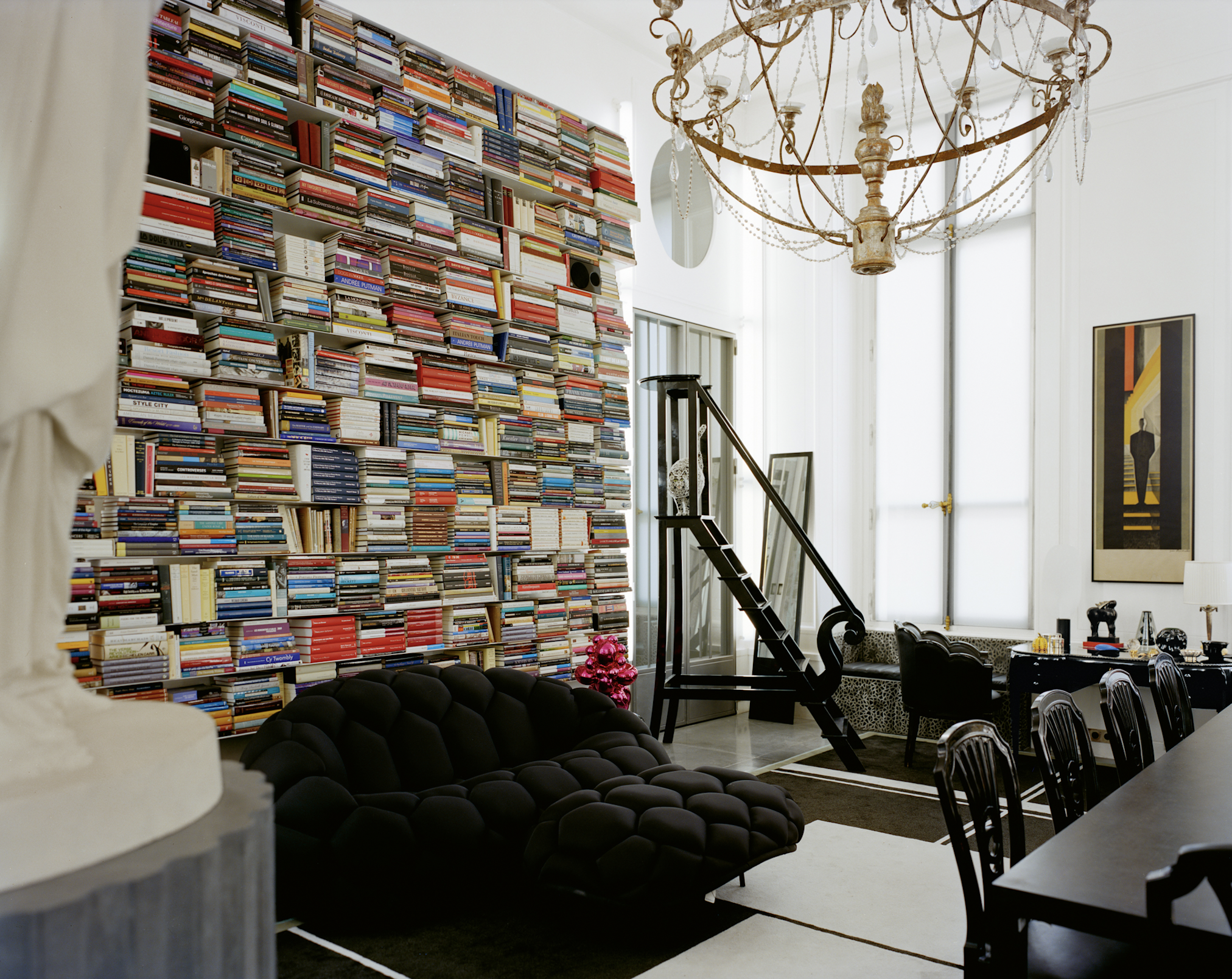
In fact, when the first Lagerfeld interior was featured in a 1968 spread for L’OEil magazine, the editorial describes him merely as a “stylist”. The photographs of the apartment in an 18th-century mansion on rue de Université, show walls lined with plum-coloured rice paper, or lacquered deepest chocolate brown in sharp contrast to crisp, white low ceilings that accentuated the horizontality that was fashionable among the extremely fashionable at the time. Yet amid this setting of aggressively au courant modernism, the anachronistic pops of Art Nouveau and Art Deco objects foreshadow the young Karl’s innate gift for creating strikingly original environments whose harmony is achieved through the deft interplay of contrasting styles and contexts.
Lagerfeld learned early on that presenting himself in a succession of gem-like domestic settings was good for crafting his image. But Lagerfeld’s houses not only provided him with publicity, they also gave him an excuse to indulge in his greatest passion. Shopping!
By 1973, Lagerfeld was living in a new apartment at Place Saint–Sulpice where his acquisition of important Art Deco treasures continued unabated. Now a bearded and muscular disco dandy, he could most often be found in the louche company of the models, starlets and assorted hedonistic beauties that gathered around the flamboyant fashion illustrator Antonio Lopez. Lagerfeld was also in the throes of a hopeless love affair with Jacques de Bascher whose favours he reluctantly shared with his nemesis Yves Saint Laurent.
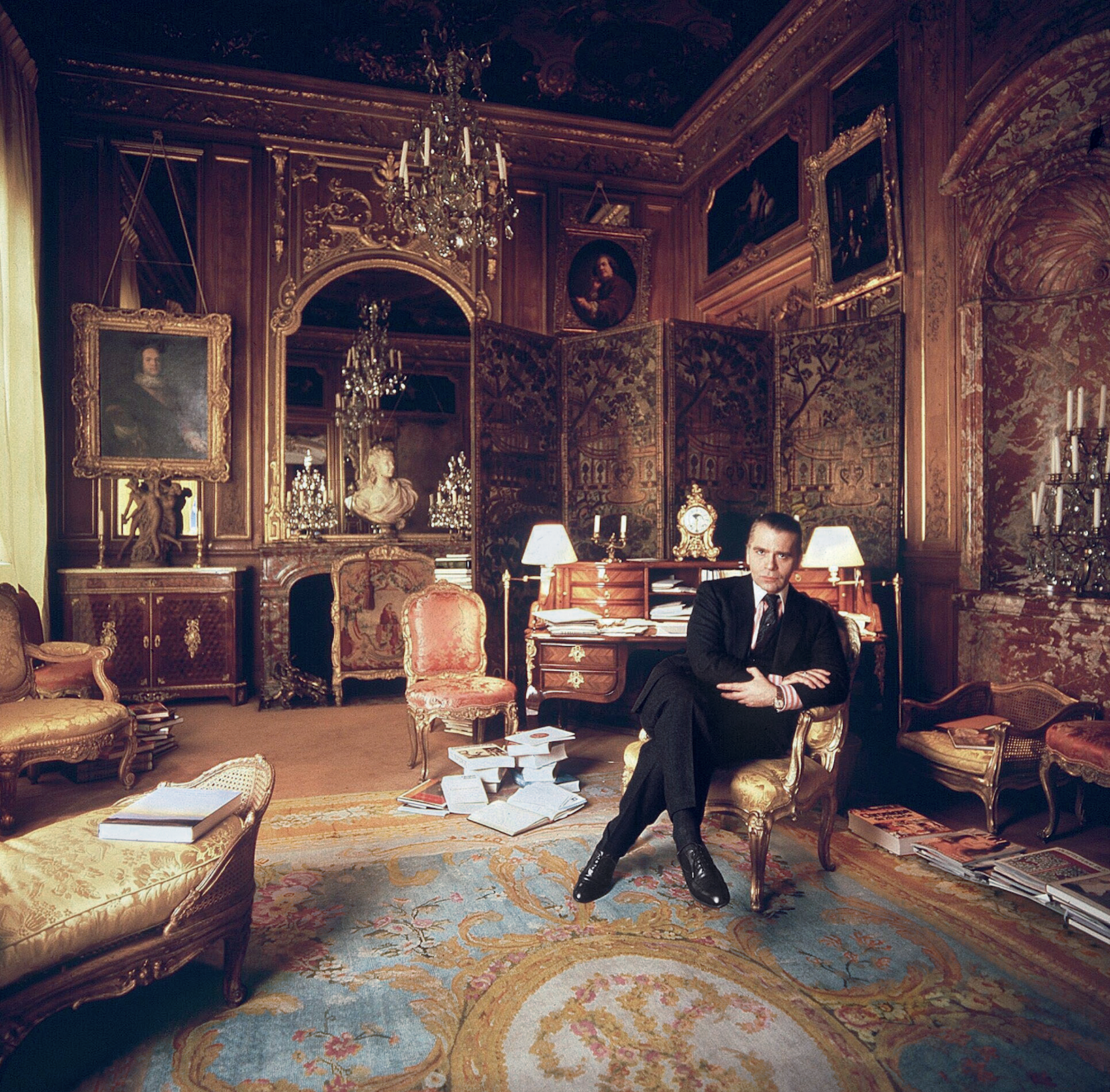
He painted the rooms milky white and lined them with specially commissioned carpets—the tawny patterned striations of which invoked musky wild animal pelts. These lent a stark relief to the sleek, machine-age chrome lines of his Deco furnishings. To contemporary eyes it remains a strikingly original arrangement that subtly conveys the tensions at play in Lagerfeld’s own life: the cocaine fuelled orgies of his lover and friends, hosted in the pristine home of a man who claimed that “a bed is for one person”.
In 1975, a painful falling out with his beloved Jacques, who was descending into the abyss of addiction, saw almost his entire collection of peerless Art Deco furniture, paintings and objects put under the auctioneer’s hammer. This was the first of many auction sales, as he habitually shed the contents of his houses along with whatever incarnation of himself had lived there. Lagerfeld was dispassionate about parting with these precious goods. “It’s collecting that’s fun, not owning,” he said. And the reality for a collector on such a Renaissance scale, is that to continue buying, Lagerfeld had to sell.
Of all his residences, it was the 1977 purchase of Hôtel Pozzo di Borgo, a grand and beautifully preserved 18th-century house, that would finally allow him to fulfill his childhood fantasies of life in the court of Madame de Pompadour. And it was in this aura of Rococó splendour that the fashion designer began to affect, along with his tailored three-piece suits, a courtier’s ponytailed and powdered coif and a coquettish antique fan: marking the beginning of his transformation into a living, breathing global brand that even those with little interest in fashion would immediately recognise.
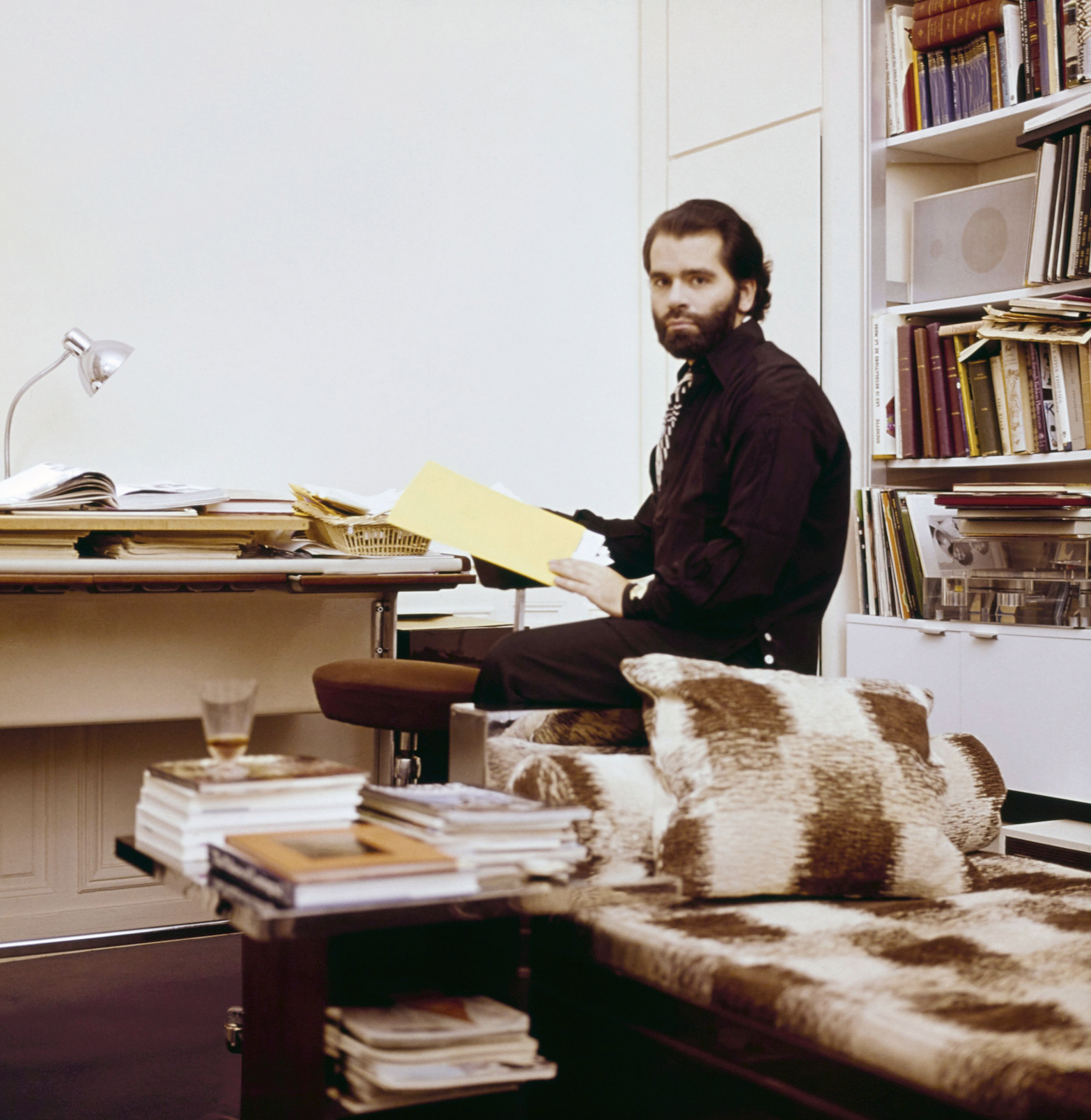
Lagerfeld’s increasing fame and financial success allowed him to indulge in an unprecedented spending frenzy, competing with deep-pocketed institutions like the Louvre to acquire the finest, most pedigreed pearls of the era—voluptuously carved and gilded bergères; ormolu chests; and fleshy, pastel-tinged Fragonard idylls—to adorn his urban palace. His one-time friend André Leon Talley described him in a contemporary article as suffering from “Versailles complex”.
However, in mid-1981, and in response to the election of left-wing president, François Mitterrand, Lagerfeld, with the assistance of his close friend Princess Caroline, became a resident of the tax haven of Monaco. He purchased two apartments on the 21st floor of Le Roccabella, a luxury residential block designed by Gio Ponti. One, in which he kept Jacques de Bascher, with whom he was now reconciled, was decorated in the strict, monochromatic Viennese Secessionist style that had long underpinned his aesthetic vocabulary; the other space, though, was something else entirely, cementing his notoriety as an iconoclastic tastemaker.
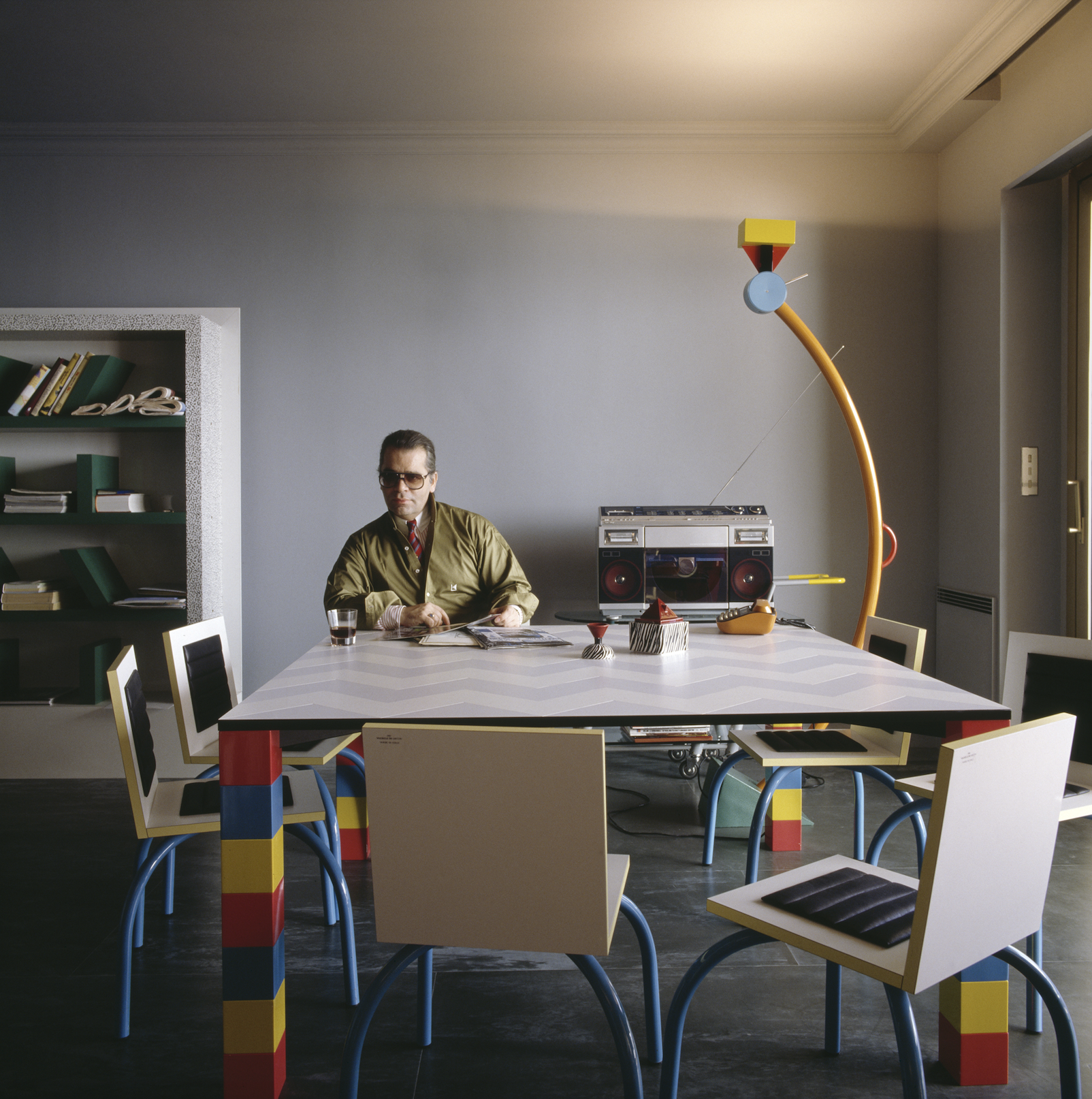
Lagerfeld had recently discovered the radically quirky designs of the Memphis Group led by Ettore Sottsass, and bought the collective’s entire first collection and had it shipped to Monaco. In a space with no right angles, these chaotically colourful, geometrically askew pieces—centred on Masanori Umeda’s famous boxing ring—gave visitors the disorientating sensation of having entered a corporeal comic strip. By 1991, the novelty of this jarring postmodern playhouse had inevitably worn thin and once again he sent it all to auction, later telling a journalist that “after a few years it was like living in an old Courrèges. Ha!”
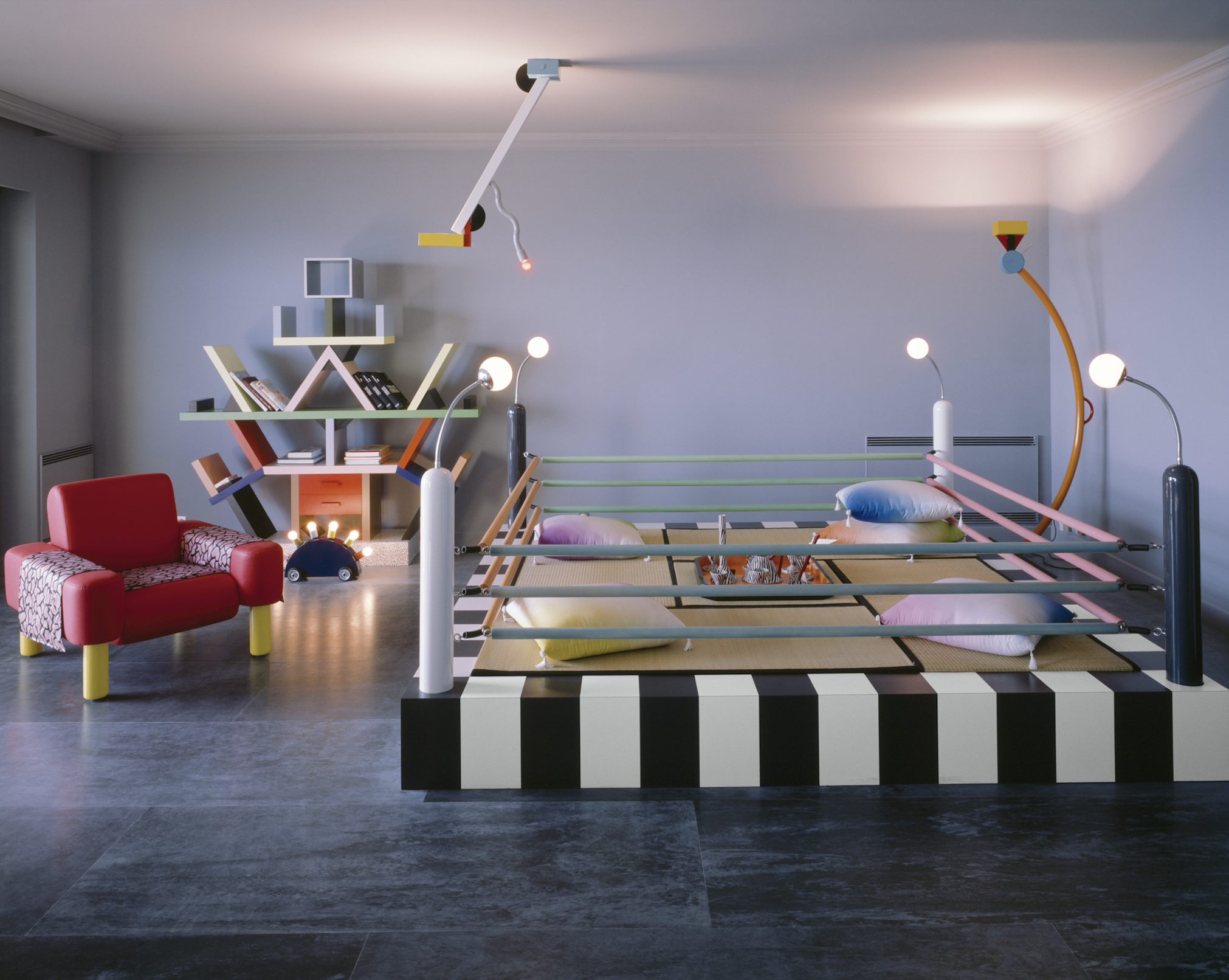
In 1989, de Bascher died of an AIDS-related illness, and while Lagerfeld’s career continued to flourish, emotionally the famously stoic designer was struggling. In 2000, a somewhat corpulent Lagerfeld officially ended his “let them eat cake” years at the Hôtel Pozzo di Borgo, selling its sumptuous antique fittings in a massive headline auction that stretched over three days. As always there were other houses, but now with his longtime companion dead, and his celebrity metastasising making him a target for the paparazzi, he began to look less for exhibition spaces and more for private sanctuaries where he could pursue his endless, often lonely, work.
His next significant house was Villa Jako, named for his lost companion and built in the 1920s in a nouveau riche area of Hamburg close to where he grew up. Lagerfeld shot the advertising campaign for Lagerfeld Jako there—a fragrance created in memorial to de Bascher. The house featured a collection of mainly Scandinavian antiques, marking the aesthetic cusp between Art Nouveau and Art Deco. One of its rooms Lagerfeld decorated based on his remembrances of his childhood nursery. Here, he locked himself away to work—tellingly—on a series of illustrations for the fairy tale, The Emperor’s New Clothes. Villa Jako was a house of deep nostalgia and mourning.
But there were more acts—and more houses—to come in Lagerfeld’s life yet. In November 2000, upon seeing the attenuated tailoring of Hedi Slimane, then head of menswear at Christian Dior, the 135 kg Lagerfeld embarked on a strict dietary regime. Over the next 13 months, he melted into a shadow of his former self. It is this incarnation of Lagerfeld—high white starched collars; Slimane’s skintight suits, and fingerless leather gloves revealing hands bedecked with heavy silver rings—that is immediately recognisable some five years after his death.
The 200-year-old apartment in Quái Voltaire, Paris, was purchased in 2006, and after years of slumber Lagerfeld—a newly awakened Hip Van Winkle—was ready to remake it into his last modernist masterpiece. He designed a unique daylight simulation system that meant the monochromatic space was completely without shadows—and without memory. The walls were frosted and smoked glass, the floors concrete and silicone; and any hint of texture was banned with only shiny, sleek pieces by Marc Newson, Martin Szekely and the Bouroullec Brothers permitted. Few guests were allowed into this monastic environment where Lagerfeld worked, drank endless cans of Diet Coke and communed with Choupette, his beloved Birman cat, and parts of his collection of 300,000 books—one of the largest private collections in the world.
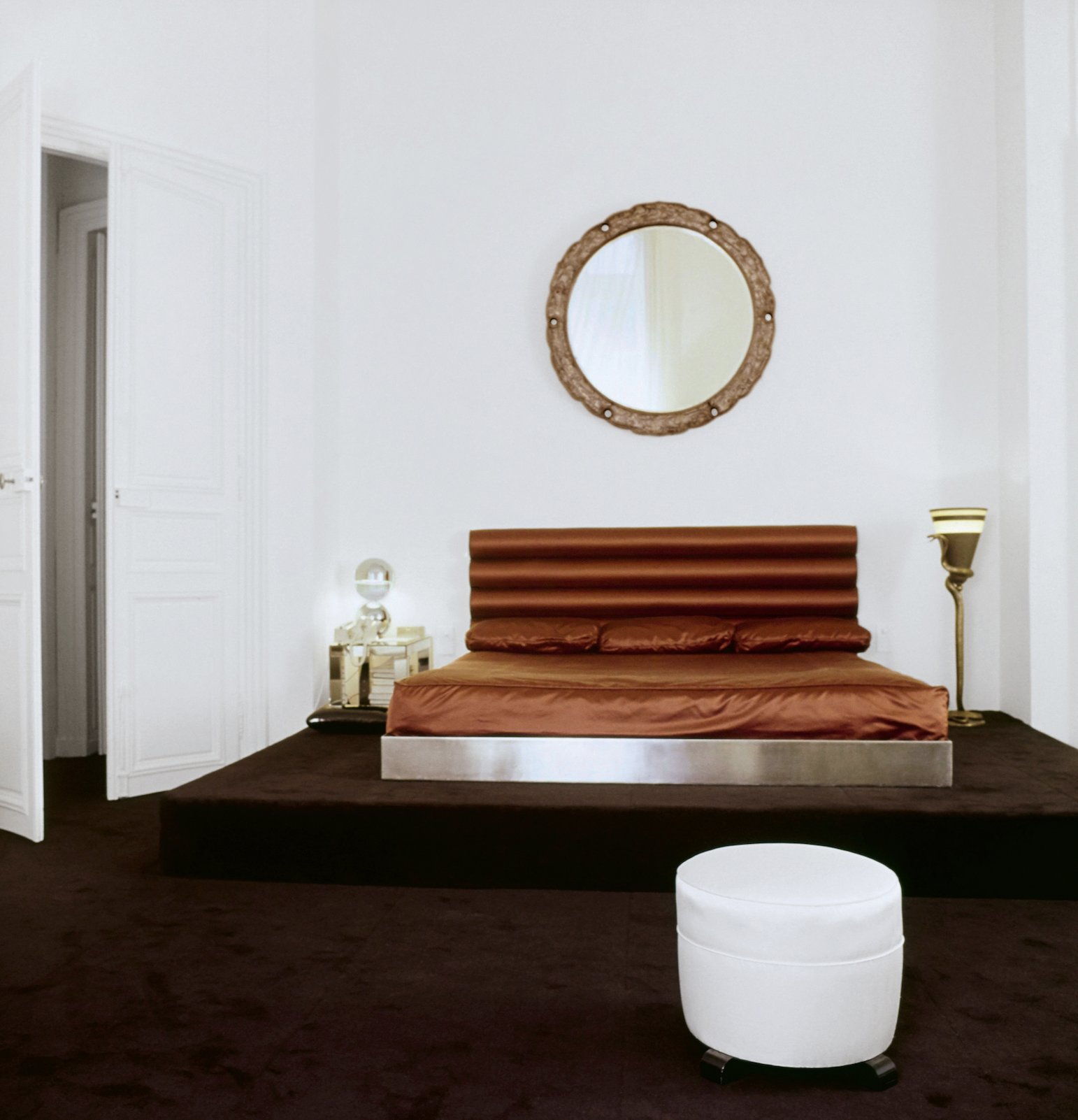
Lagerfeld died in 2019, and the process of dispersing his worldly goods is still ongoing. The Quái Voltaire apartment was sold this year for US$10.8 million (around $16.3 million). Now only the rue de Saint-Peres property remains within the Lagerfeld trust. Purchased after Quái Voltaire to further accommodate more of his books—35,000 were displayed in his studio alone, always stacked horizontally so he could read the titles without straining his neck—and as a place for food preparation as he loathed his primary living space having any trace of cooking smells. Today, the rue de Saint-Peres residence is open to the public as an arts performance space and most fittingly, a library.
You may also like.
By Josh Bozin
24/07/2024
Watch This Space: Mike Nouveau
Meet the game-changing horological influencers blazing a trail across social media—and doing things their own way.
In the thriving world of luxury watches, few people own a space that offers unfiltered digital amplification. And that’s precisely what makes the likes of Brynn Wallner, Teddy Baldassarre, Mike Nouveau and Justin Hast so compelling.
These thought-provoking digital crusaders are now paving the way for the story of watches to be told, and shown, in a new light. Speaking to thousands of followers on the daily—mainly via TikTok, Instagram and YouTube—these progressive commentators represent the new guard of watch pundits. And they’re swaying the opinions, and dollars, of the up-and-coming generations who now represent the target consumer of this booming sector.
—
MIKE NOUVEAU

Can we please see what’s on the wrist? That’s the question that catapulted Mike Nouveau into watch stardom, thanks to his penchant for highlighting incredibly rare timepieces across his TikTok account of more than 400,000 followers. When viewing Nouveau’s attention-grabbing video clips—usually shot in a New York City neighbourhood—it’s not uncommon to find him wrist-rolling some of the world’s rarest timepieces, like the million-dollar Cartier Cheich (a clip he posted in May).
But how did someone without any previous watch experience come to amass such a cult following, and in the process gain access to some of the world’s most coveted timepieces? Nouveau admits had been a collector for many years, but moved didn’t move into horology full-time until 2020, when he swapped his DJing career for one as a vintage watch specialist.
“I probably researched for a year before I even bought my first watch,” says Nouveau, alluding to his Rolex GMT Master “Pepsi” ref. 1675 from 1967, a lionised timepiece in the vintage cosmos. “I would see deals arise that I knew were very good, but they weren’t necessarily watches that I wanted to buy myself. I eventually started buying and selling, flipping just for fun because I knew how to spot a good deal.”
Nouveau claims that before launching his TikTok account in the wake of Covid-19, no one in the watch community knew he existed. “There really wasn’t much watch content, if any, on TikTok before I started posting, especially talking about vintage watches. There’s still not that many voices for vintage watches, period,” says Nouveau. “It just so happens that my audience probably skews younger, and I’d say there are just as many young people interested in vintage watches as there are in modern watches.”
View this post on Instagram
Nouveau recently posted a video to his TikTok account revealing that the average price of a watch purchased by Gen Z is now almost US$11,000 (around $16,500), with 41 percent of them coming into possession of a luxury watch in the past 12 months.
“Do as much independent research as you can [when buying],” he advises. “The more you do, the more informed you are and the less likely you are to make a mistake. And don’t bring modern watch expectations to the vintage world because it’s very different. People say, ‘buy the dealer’, but I don’t do that. I trust myself and myself only.”
—
Read more about the influencers shaking up horology here with Justin Hast, Brynn Wallner and Teddy Baldassare.
You may also like.
By Josh Bozin
24/07/2024
This Pristine 1960 Ferrari 250 Spider Could Fetch $24 Million at Auction
The car wears the same colours and has the same engine it left the factory with.
Some Ferraris are just a little bit more important than others.
Take, for example, the 1960 250 GT SWB California that RM Sotheby’s is auctioning off during this year’s Monterey Car Week. Any example of the open-top beauty would attract interest, but this one just so happens to be the first one that was built.
The 250 is one of the most legendary series of cars in Ferrari history. Between 1952 and 1964, the company released 21 different 250 models—seven for racetracks, 14 for public roads—of which the “Cali Spider” might be the most well regarded, thanks to its potent V-12 and a Pininfarina-penned design that is one of the most beautiful bodies to grace an automobile. The roadster, which was specifically built for the U.S., made its debut in 1957 as a long-wheel-base model (LWB), but it wasn’t until the SWB model debut in 1960 that it became clear how special it was. This example isn’t just the first to roll off the line. It’s the actual car that was used to introduce the world to the model at the 1960 Geneva Motor Show.
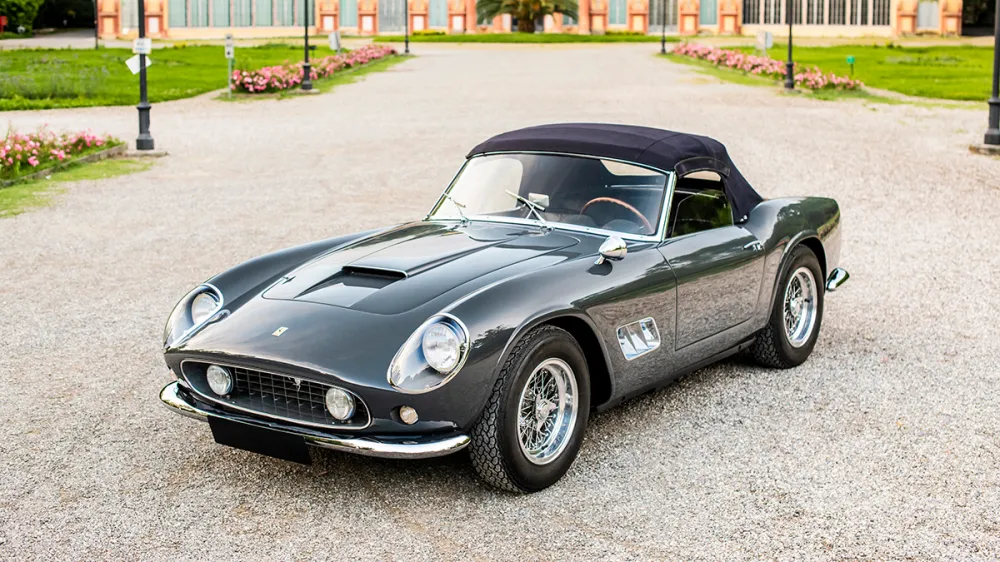
Just 56 examples of the 250 GT SWB California Spider would be built by Scaglietti during the three years it was in production. The first of those, chassis 1795 GT, is finished in a glossy coat of Grigio. The two-door had a red leather interior at Geneva but was returned to the factory and re-outfitted with black leather upholstery before being delivered to its original owner, British race car driver John Gordon Bennet. Six-and-a-half decades later the car looks identical to how it did when it left the factory the second time.
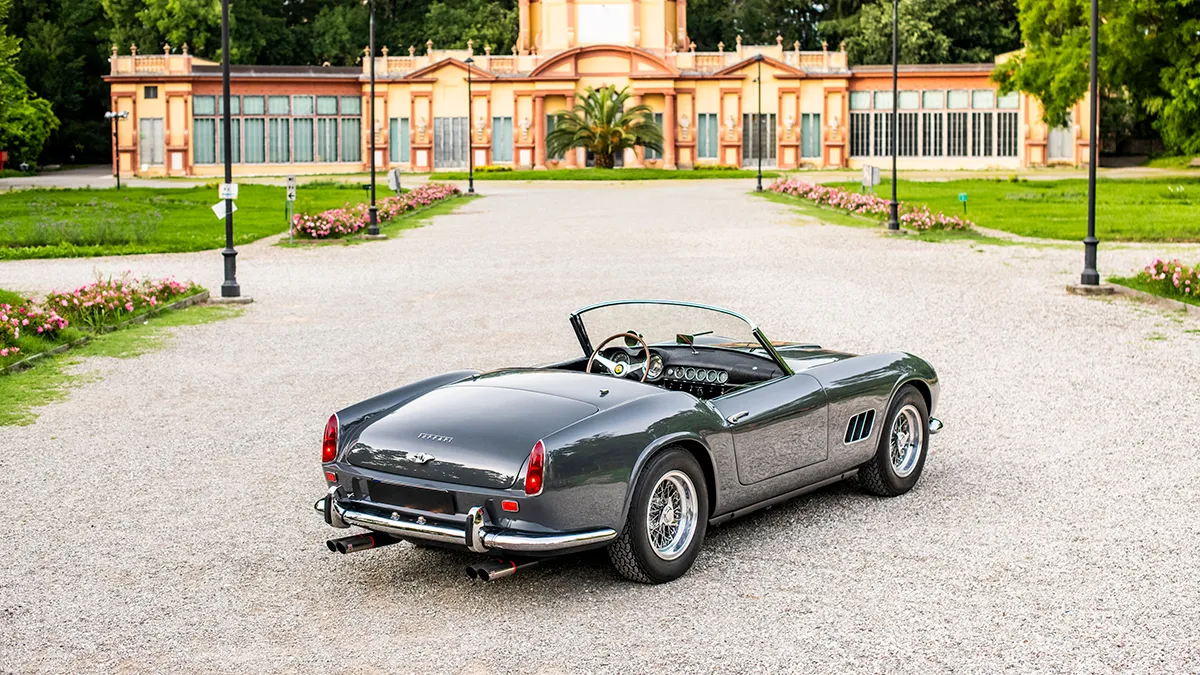
In addition to its original bodywork, the chassis 1795 GT features its original engine, gearbox, and rear axle. That mill is the competition-spec Tipo 168, a 3.0-litre V-12 that makes 196.1 kW. That may not sound like much by today’s standards, but, when you consider that the 250 GT SWB California Spider tips the scales around 952 kilograms, it’s more than enough.
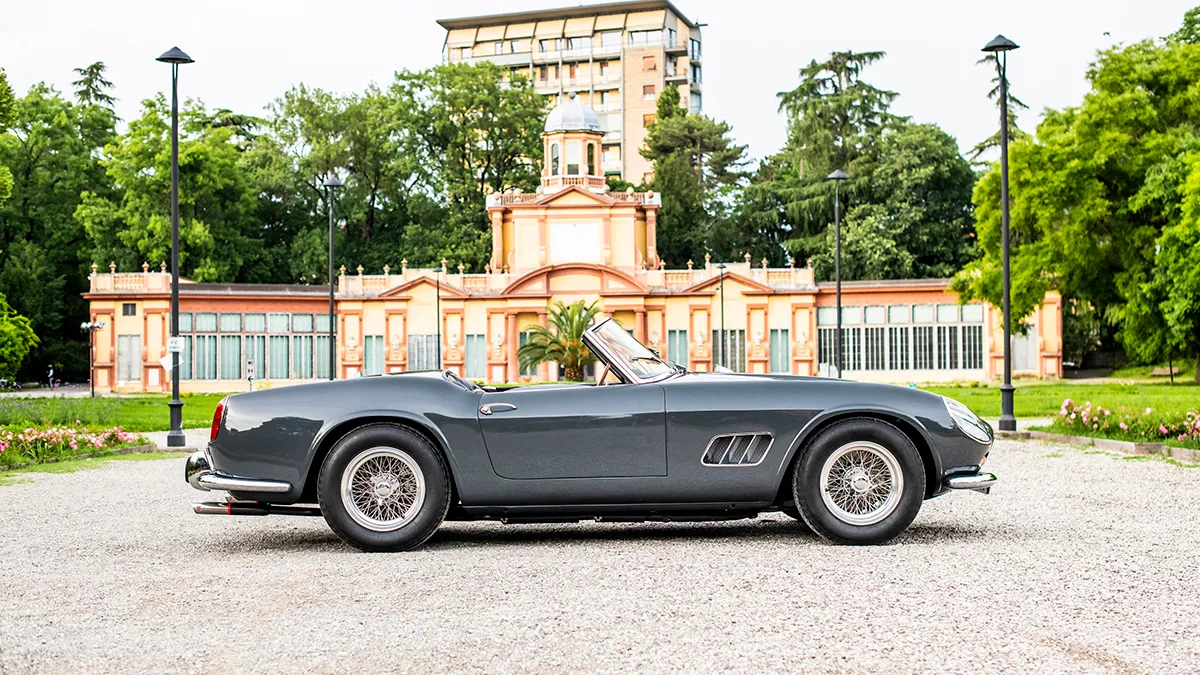
The first 250 GT SWB California Spider is scheduled to go up for bid during RM Sotheby’s annual Monterey Car Week auction, which runs from Thursday, August 15, to Saturday, August 17. Unsurprisingly, the house has quite high hopes for the car. The car carries an estimate of between $24 million and $26 million, which could make it one of the most expensive cars ever sold at auction.
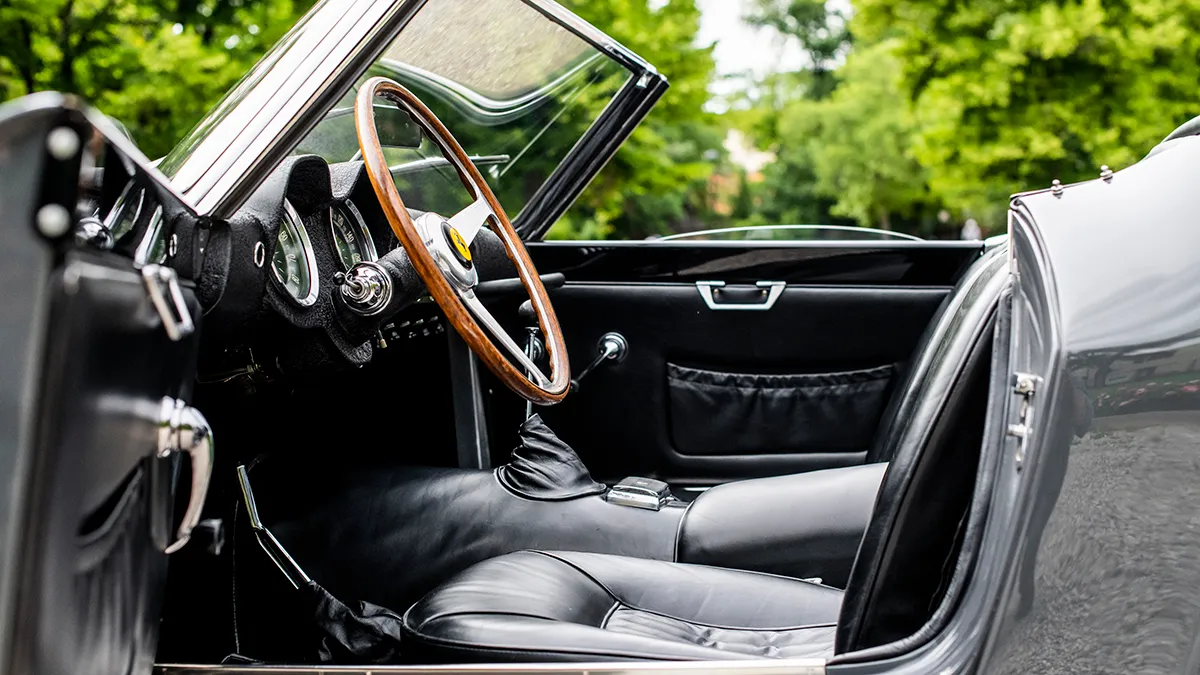
You may also like.
By Josh Bozin
24/07/2024






